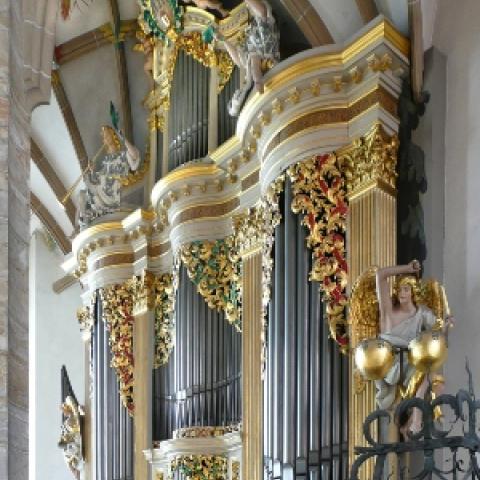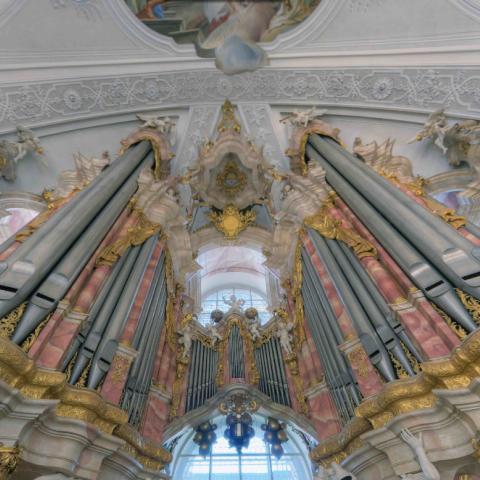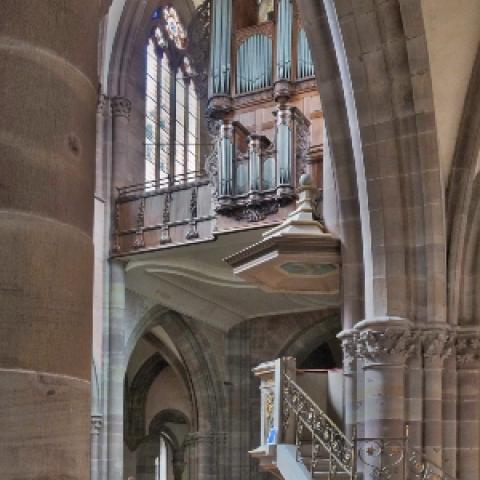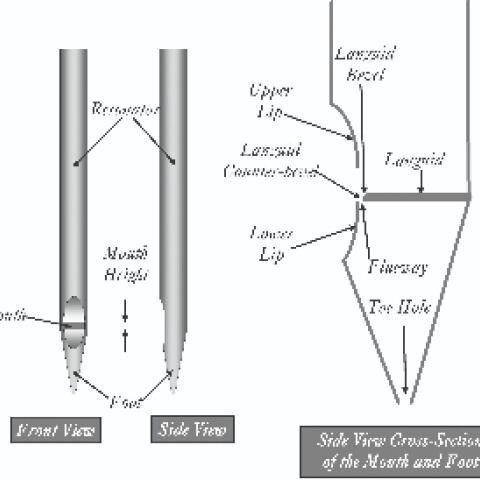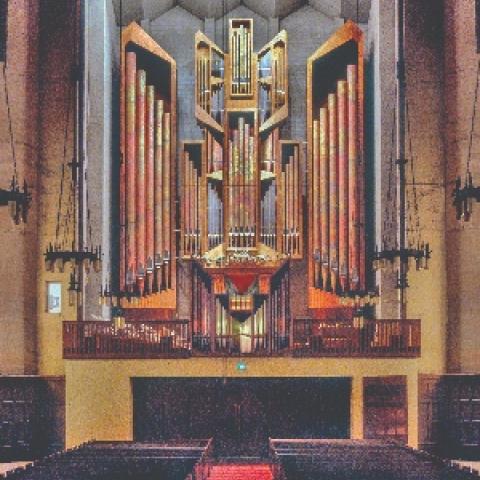An analysis by Michael McNeil from data published in 2016 by William Drake, Ltd., Organbuilder
Michael McNeil has designed, constructed, and researched pipe organs since 1973. He was also a research engineer in the disk drive industry with twenty-seven patents. He has authored four hardbound books, among them The Sound of Pipe Organs, several e-publications, and many journal articles.

Editor’s note: The Diapason offers for the first time here a new feature at our digital edition—two sound clips. Any subscriber can access this by logging into our website (www.thediapason.com), click on Current Issue, View Digital Edition, scroll to this page, and click on <soundclip> in the text.
John Snetzler
By 1750 England had become a nation with a large middle class with an appetite for music and art performance. “It proved to be a magnet to foreigners such as Handel and J. C. Bach. It is no surprise at all to find a continental organbuilder making a substantial impact in England in the 1750s.”1 John Snetzler, born in Schaffhausen, Switzerland, in 1710, may have arrived in London as early as 1740. His earliest known instruments date from 1742, one of them a chamber organ at Yale University, New Haven, Connecticut. According to Charles Burney, who knew Snetzler personally, he may have worked on Christian Müller’s famous organ at the Bavokerk in Haarlem, the Netherlands, during its construction in 1735 to 1738.2 Although his stop nomenclature looks very much like normal English fare of the time, Snetzler’s sound is much bolder and brighter. This voicing style led to the development of true string tone in Snetzler’s Dulcianas.
Large contracts for English cathedrals eluded him, and Snetzler never achieved the fame of builders like Samuel Green. He produced many smaller chamber organs along with a few larger instruments. According to Bicknell, Snetzler may have been excluded by the remains of the Guild system.
“To claim that Snetzler cornered the market in chamber organs would be an exaggeration, although it is difficult to escape the conclusion that he led the field in re-establishing their popularity.”3 Bicknell was a gifted English writer, fully at ease in organbuilding technology, music theory, and historical context. His description of a chamber organ built by Snetzler in 1763 for Radburne Hall, Derbyshire, but now residing in Schaffhausen, Switzerland, gives a clear idea of Snetzler’s tonal concept:
A pedal raises and lowers the lid of the organ to provide a simple swelling device. In 1982 the organ was very clean and well preserved and still retained most of its original leather work. The pipes had been crudely torn to alter the tuning, but once repairs had been made it became clear that the instrument had been tuned in 1⁄4-comma meantone temperament or something very close to it. The effect, in the home keys, of the Fifteenth and the strong quint and tierce in the Sesquialtera and Cornet is astonishingly bold. The effect of playing a chord of C major, with the tutti very strongly coloured by dissonant intervals in the upperwork, is disconcerting. Moreover, the Stopped Diapason and Flute sound the unison rather weakly, with a very strong first harmonic (the octave quint). The result is that the notes of a G major triad are represented almost as strongly as those of C major. To analyse a chorus in this way is to challenge the very principles of organ tone, and it has to be accepted that the multiple dissonances and consonances found in a principal chorus actually produce a musical effect full of interest and colour. But here, with such a Spartan distribution of the harmonic components and heard at very close quarters the tonality of this or any other chord is highly ambiguous. However, as soon as it is put into musical context, all becomes clear, and the vigour and daring of Snetzler’s method is suddenly justified. The combination of boldly voiced mutations and shifting patters of consonance and dissonance (always a part of a performance on a keyboard instrument tuned to meantone temperament) highlights the harmonic structure of the composition played, and in particular emphasises modulations away from the home key. That home key will itself have its own colour, depending on how many sharps or flats it has. This tonal world is one that is almost completely unfamiliar to modern ears, despite the early music movement and interest in authentic performance: the insights it provides are well worth pursuing.4
Snetzler built a chamber organ in 1755 with one of his larger specifications, whose original provenance is unknown but today resides in Clare College, Cambridge, and has survived without significant alterations. The “vigour and daring of Snetzler’s method” can be heard in a Youtube recording of this organ (pre-restoration) of Bach’s Fugue in C Minor, BWV 575.5 <soundclip1 here> Although containing only one manual and no pedal, it extends in the English style of the time from GG, AA to f′′′, a compass that descends well into the 16′ octave. The performance of the fugue incorporates the use of this extended bass compass with revisions to the score to accommodate the original pedal line. The balances in the voicing allow all voices to be clearly heard and the emotional impact is startling.
Like other English builders of his time Snetzler used a form of meantone tuning (not heard in the Youtube recording), whose pure or nearly pure major thirds added significant gravity with their low resultants. The gravity of meantone tuning along with the extended manual bass compass goes a long way to explain why the lack of an independent pedal persisted in English organs well into the early nineteenth century.6 <soundclip2 here>
But what makes this particular organ most interesting is that it has been restored and documented in unprecedented detail by William Drake, Ltd., who have placed on their website descriptions, drawings, data, and photographs from which Snetzler’s work can be fully understood.7 This is no small achievement; organs are almost never documented in such detail.
Preface to the analysis
Good documentation of organs with enough pipe measurements to permit an analysis of both scaling and voicing is extremely rare. Pipe diameters, mouth widths, and mouth heights (cutups) may be found to some degree, but toe diameters and especially flueway depths are extremely rare. William Drake, Ltd.’s documentation of the 1755 Snetzler organ includes all of this and much more—detailed dimensions of the windchest and wind system that allow a full analysis of wind flow and wind dynamics, parameters having an enormous impact on the sound of an organ. A full narrative of the restoration in William Drake, Ltd’s. documentation includes the data that support the very few restorative changes made to the instrument, all of which were guided by carefully documented investigative work.
William Drake, Ltd., gives us a good model for documentation, where they have chosen to provide photographs and detailed hand drawings of the organ along with the important dimensions. While computer drawings are nice, most organbuilders do not have the time or funding to make them. If we want to see good documentation in print, we must also be willing to accept the lack of polish in hand drawings. The editorial staff of The Diapason has shown courage in their willingness to publish such drawings.
The data in this analysis are presented in normalized scales for inside pipe diameters, mouth widths, and mouth heights. Tables showing how raw data are converted into normalized scales may be found in the article on the E. & G. G. Hook Opus 322 published in The Diapason, July 2017, pages 17–19. The set of data and the Excel spreadsheet used to analyze the Snetzler may be obtained at no charge by emailing the author.8 Readers interested in a deeper understanding of the models used in the analysis may refer to the book The Sound of Pipe Organs.9
Pitch, temperament, wind pressure, and compass
The Snetzler organ is pitched at A = 422.5 Hz at 17.5 degrees Celsius. The current tuning is Young II temperament with indications of original meantone. The wind pressure, water column, is quite low at 51 mm (2 inches). The compass is GG, AA to f′′′. The organ has no pedal but derives bass tone from its extended manual compass, which with its lower pitch extends nearly a halftone below GG. The stops are divided bass and treble:
Bass, GG, AA to b
Sesquialtera (17–19–22)
Principal (4′, full compass)
Flute (4′)
Dulciana (8′, GG to F# grooved)
Diapason (8′)
Treble, c′ to f′′′
Hautbois (8′, expressive)
Cornett (8–12–17)
Fifteenth (2′, full compass)
Flute (4′)
Dulciana (8′)
Diapason (8′)
The wind system
The wind system can be modeled from two viewpoints: 1) the restriction of flow from the areas of the wind trunks, pallets, channels, and pipe toes, and 2) the dynamics of the wind. Wind dynamics are fully explained in The Sound of Pipe Organs and are a very important aspect of an organ’s ability to sustain a fast tempo with stability or enhance the grand cadences of historic literature. The superb data set on the Snetzler allows us to explore all of these characteristics. Figure 1 shows the Snetzler wind flow model.
In Figure 1 we see two lists of all of the stops with the pipe toe diameters for a note in each octave in the compass at the top and their calculated areas directly below. These toe areas are then added together (this is the first set of boxed values). The key channels must be sufficiently large to flow wind to these pipe toes, and the pallets activated by the keys must be sufficiently large to flow wind to the key channels.
A model for the total required wind flow of the full organ assumes a maximum of ten pallets (a ten-fingered chord) as described in the next line in the table, and the combined toe areas are multiplied by the number of these pallets played in each octave of the compass. Here we see that the sum of the flow of all of the pipe toes in the full organ (the next boxed value) is 2,982 mm2.
Next in the table are values for the pallet opening lengths, the extent that the pallets are pulled open when a key is depressed (estimated from the ratios in the drawings), and the height and widths of the key channels that are fed wind by the pallets. These data allow us to calculate the relative wind flow of the channels (height times width), and we find that there are robust margins in the windflow from the channels to the pipe toes (see the boxed values of 201% at low GG to 549% at high c′′′).
Now we can calculate the flow of the pallets that feed the channels (the sum of the opening length and channel width times the pallet pull), and we find the ratio of the flow of the pallet openings to the channels (the next boxed values) is less robust and ranges from 88% in the bass to 187% in the high treble. The pallets still adequately flow wind to the bass pipes when we consider the more robust margins in channel flow. The estimate of the pallet pull may also be low. It is interesting to speculate that pallets that just barely flow the required wind to the channels may allow some degree of modulation of touch to the organist. Smaller pallets also require less force to open and are easier to play.
The next value, the area of the wind trunk, is 10,230 mm2, and we see that the area of the wind trunk affords 3.4 times more wind than all of the pipe toes in the full organ, so much in fact that it does not function as an effective resistance in the system. Interestingly, the Isnard organ at St. Maximin uses the wind trunk as a strong resistor to dampen Helmholtz resonances in the wind system, and it has a ratio of wind trunk area to a plenum toe area of 1.07 for the coupled principal chorus of the Grand-Orgue and Positif (no reeds, flutes, or mutations). Helmholtz resonances are the source of what is normally called wind shake, and we might expect some mild wind shake with the Snetzler wind system with its large wind duct and low damping.
The underlying dynamics of a wind system are the result of its mass and volume. These factors produce a natural resonance that can enhance the grand cadences of literature with a long surge in the wind, or it can produce a nervous shake if it is too fast. A grand surge in the wind is characterized by a resonant frequency of less than 2Hz (cycles per second), and it is most often produced by a weighted wedge bellows. A nervous shake is characterized by much higher resonant frequencies, and it is produced by a sprung, vertical rise bellows with low mass. We correct the latter condition with small concussion bellows in modern organs, but the Snetzler wind system does not have such devices; instead, it features a weighted wedge bellows.
We can model the dynamic response of an organ by using its wind pressure, the area of the bellows plate, and the combined internal volume of its bellows, wind trunk, and pallet box. The model in Figure 2 shows the dynamic response of the Snetzler wind system at a relaxed 1.52 Hz, producing a wind surge of 0.66 seconds. William Drake, Ltd., found that the original wedge bellows had been modified to a vertical rise design, which the model shows would have resonated at about 2.26 Hz with 0.44 seconds surge, and they wisely restored the original design. The restorers found that with the wedge bellows, “The wind is lively but smooth and enhances the sound in a musically pleasing way.”7
The scaling
The Normal Scale of pipe diameters is a way to visualize relative power, where a flat line from bass to treble will produce relatively constant power. Pipes with data extending higher in the graph will produce more power. Each half tone on the vertical scale is worth 0.5 dB of power. Readers may refer to The Sound of Pipe Organs, pages 8–32, for a discussion of the underlying theory and principles. The Snetzler metal principal chorus pipes have a constant scale where all pipes of the same pitch have the same diameter regardless of the stops in which they appear. Snetzler mildly increased his treble scales from about 1⁄2′ in pitch in Figure 3, a reflection of the smaller acoustics of chamber organs and less need to compensate for distance losses. The flute has wider treble scales. The Snetzler Dulciana descends dramatically; it shares the bass with the Diapason. The scales of the wood pipes are represented by their diagonals, not their relative areas; this represents the true power capability of the standing wave in the pipe, as pointed out by John Nolte, and correctly relates to metal pipes. The GG compass is represented by notations on the pitch axis as “10, 5, 2.5,” indicating rough approximations of the length in feet for the extended bass compass.
The Normal Scale of mouth widths operates just like the pipe diameters, where a flat line from bass to treble will produce relatively constant power. Pipes extending higher in the graph will produce more power. Each half tone on the vertical scale is worth 0.5 dB of power.
Mouth widths are nearly always a better indicator than pipe diameters of power balances; this is because mouth widths can be designed to vary considerably within the same diameters of pipes. Narrower mouths will produce less power, other voicing parameters like flueways and toe diameters being equal.
In Figure 4 we see that Snetzler greatly reduced the mouth widths of the 8′ Diapason and the 4′ Flute. The mouth width reduction of the Diapason in Figure 4 reduces the power to blend seamlessly into the tenor of the Dulciana; it also makes the upperwork seem relatively much more powerful. This example of the seamless blend of the Snetzler mouth widths for the Diapason and the Dulciana shows why it is often advantageous to use mouth widths, not diameter scales, to understand the balances of power in a chorus. The Dulciana has very narrow mouths consistent with its role as a soft string stop.
The voicing
Mouth height, or “cutup” as it is commonly called by voicers, is the primary means of adjusting the timbre of a pipe. Low cutups will create a bright tone with many higher harmonics while high cutups will produce smoother tone. Readers may refer to The Sound of Pipe Organs, pages 68–80. It is not uncommon to find flute pipes cut as much as 12 half tones higher than principal pipes in classical pipe organs.
In the Normal Scale of mouth heights, a higher cutup value on the vertical scale will result in smoother tone. Cutups may be adjusted higher for two reasons: 1) the voicer wants a smoother timbre, or 2) the voicer wants more power at the same timbre. More power means more wind, and this means a larger toe or flueway opening to admit more wind. More wind will always produce a brighter tone, so the voicer can make a pipe louder and preserve the original timbre by opening the toe or flueway and raising the cutup until the timbre is restored.
Pipe toe diameters can be normalized (this is the “C” parameter in Figure 6) to the diameter of the pipe, the width of the mouth, and the depth of the flueway; larger values of “C” will admit more wind to the pipe. Readers may find the derivation of this normalization in The Sound of Pipe Organs, pages 43–47.
Now we can understand the Snetzler graphs. In Figure 5 we see exceptionally low cutups in the bass that are low even for the very modest 51 mm. pressure. Snetzler’s use of bold nicking on the languids of the bass and mid-range pipes stabilizes the speech with such low cutups. This is consistent with the “slower” speech of Snetzler’s voicing, where the languids are kept high and the resulting timbre is brighter (the speech is not actually slower, just brighter—the pipes are slower to overblow to the octave on higher pressure).10 Gottfried Silbermann took this concept to an extreme with upper lips constructed to extend far in front of the flueway; this virtually required the voicer to raise the languid well above the edge of the lower lip, with the consequence that the timbre became very bright. Snetzler was more moderate in his use of this voicing technique.
But lower mouth heights can also be explained by reduced toe diameters, and we see very consistent and greatly reduced toe diameters for the Snetzler upperwork in Figure 6 where only the wood pipes of the 8′ Diapason and 4′ Flute have generous toes. As we will see later, those wood pipes also have reduced flueways. The reduction in toe diameters in Figure 6 reduces the wind pressure at the mouth of those stops, allowing the use of lower cutups.
Of interest in Figure 6 are Snetzler’s very reduced toes on the 8′ Dulciana stop. This is consistent with the very low mouth heights of this stop in Figure 5, giving the stop low power with significant harmonic overtone structure; Snetzler used box beards to stabilize the speech of the Dulciana. Taken together, this is a very powerful demonstration of Snetzler’s skills in scaling and voicing where he achieves good balances with the metal chorus pipes and the common bass with the Dulciana.
Like the pipe toe, flueway depth controls the flow of wind and strongly correlates to the power and the speed of the speech of the pipe. Readers may refer to The Sound of Pipe Organs, pages 50–63 and 77–82.
In Figure 7 we see very generous flueways for the metal pipes of the Snetzler chorus, while the wood pipes and Dulciana have much more restrained flueways. In the chorus pipes Snetzler is controlling the power balances with scaling and toe diameters, not flueways, a technique more commonly found in classical French voicing. The reduced flueways of Snetzler’s wood Diapason and Flute are more typical of classical Germanic voicing, where power is controlled at the flueway rather than the toe. It is unusual to find a chorus with both voicing styles.
The languids are boldly nicked at an angle in the bass pipes progressing to finer nicks in the higher pitches and ultimately little or no nicking in the highest trebles. Ears are present on pipes up to 1-1⁄3′ pitch and absent at higher pitches. Upper lips are lightly skived to about one half of the metal thickness.
The flow of wind and power balances are controlled by the voicer at the toe and flueway of a pipe. The ratio of the area of the toe to the area of the flueway is important. If the area of the toe is less than the area of the flueway, which is a ratio less than “1,” the speech will be slower. “Slowness” in this instance does not refer to the voicer’s term (which reflects how the voicer adjusts the relative position of the languid and upper lip), but rather to the effect of resistances (toe and flueway areas) and capacitance (volume of the pipe foot) on the rate of the buildup of pressure at the mouth, which in turn affects the buildup of pipe speech to full power. Readers may refer to The Sound of Pipe Organs, pages 56–63 and 114–116, for a discussion of this very important musical characteristic. A well-knit chorus of pipes may have pipes that speak less promptly or pipes that speak more promptly, but never both; a chorus with both would have a confused and ill-defined attack. The effect here is subtle and measured in milliseconds, but the human ear is very sensitive to such fine variations.
The ratio is exactly “1” when the area of the toe and flueway are equal, and this is the normal lower limit for pipes with prompt speech; for example, the vast majority of the principal chorus pipes in the Isnard organ at St. Maximin in the range of 4′ to 1′ pitch exhibit a value of almost exactly “1,” with the highest pitches approaching a value of “3.”
The wood pipes of the 8′ Diapason and 4′ Flute in Figure 8 have ratios far in excess of “1,” and this is another way of looking at Snetzler’s technique for pushing these pipes harder with their narrower mouth widths and narrower flueways. In stark contrast, the Snetzler metal pipes have ratios trending at or well below a value of “1,” suggesting that they speak a bit less promptly. The recording made by Anne Page prior to the restoration demonstrates the full chorus and supports this conclusion. Slightly slower speech is not necessarily a defect, and it can be used to dramatic advantage.
Very rarely do we find anything in the organ literature about voicing, and very rarely do we find documentation with enough data to analyze the voicing of an organ. With William Drake, Ltd.’s data we can understand Snetzler’s voicing and tonal concepts in depth.
Further paths
This short essay cannot begin to do justice to the documentation done by William Drake, Ltd., on the Snetzler organ. Readers are encouraged to visit their website to view their wonderful PDF files.7 The casual reader can simply peruse the photos and notes to see what the inside of an eighteenth-century organ looks like. The motivated organbuilder can fully recreate the Snetzler sound from these notes. This is a gold standard of documentation.
Notes
1. Stephen Bicknell, The History of the English Organ, Cambridge University Press, 1996, Cambridge, p. 174.
2. Ibid, p. 174.
3. Ibid, pp. 203–204.
4. Ibid, pp. 204–206.
5. Anne Page, Fugue in C minor, BWV 575, www.youtube.com/watch?v=slgjVr97FLY. This is a pre-restoration recording made during the 2011–2012 time frame. The volume is set very low in this recording and should be turned up. It is important to keep in mind that the tuning has been modified from its original meantone to something much closer to modern equal temperament.
6. The gravity induced by meantone must be heard to be appreciated. The 1739 Clicquot organ at Houdan is tuned in meantone and may be heard to advantage in the superb new recording reviewed in The Diapason, July 2018, p. 15, Magnificat 1739, Regis Allard, available from www.editionshortus.com. This organ has no 16′ stops, but 16′ tone is strongly evident in the resultants of the pure major thirds.
7. William Drake, Ltd., The Restoration of the 1755 John Snetzler Organ at Clare College, Cambridge, PDF documents accessed August 16, 2016, www.williamdrake.co.uk/portfolio-items/clare-college-cambridge/.
8. The author’s email address is: mcneilmichael83@gmail.com.
9. Michael McNeil, The Sound of Pipe Organs, CC&A, 2012, Mead, 191 pp., Organ Historical Society and Amazon.com.
10. The History of the English Organ, p. 178, “Snetzler’s chorus consists of ranks all made to the same scale and voiced at the same power . . . . The speech of the individual pipes is significantly slower than that of earlier generations, and this encourages brightness (as well as facilitating the development of the new string-toned stops). Any tendency of the pipes to spit or scream is controlled by the consistent use of firm, slanted nicking on the languids of the pipes—a hallmark of Snetzler material.” Joost de Boer, the director of William Drake, Ltd., confirmed the use of higher languids and slower speech on the Snetzler pipes in a personal communication in 2018.

